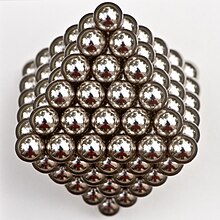
| ||||
|---|---|---|---|---|
| ← 140 141 142 143 144 145 146 147 148 149 → ← 0 100 200 300 400 500 600 700 800 900 → | ||||
| Cardinal | one hundred forty-six | |||
| Ordinal | 146th (one hundred forty-sixth) | |||
| Factorization | 2 × 73 | |||
| Divisors | 1, 2, 73, 146 | |||
| Greek numeral | ΡΜϚ´ | |||
| Roman numeral | CXLVI, cxlvi | |||
| Binary | 100100102 | |||
| Ternary | 121023 | |||
| Senary | 4026 | |||
| Octal | 2228 | |||
| Duodecimal | 10212 | |||
| Hexadecimal | 9216 | |||
146 (one hundred forty-six) is the natural number following 145 and preceding 147.
In mathematics
146 is an octahedral number, the number of spheres that can be packed into in a regular octahedron with six spheres along each edge. For an octahedron with seven spheres along each edge, the number of spheres on the surface of the octahedron is again 146. It is also possible to arrange 146 disks in the plane into an irregular octagon with six disks on each side, making 146 an octo number.
There is no integer with exactly 146 coprimes less than it, so 146 is a nontotient. It is also never the difference between an integer and the total of coprimes below it, so it is a noncototient. And it is not the sum of proper divisors of any number, making it an untouchable number.
There are 146 connected partially ordered sets with four labeled elements.
See also
References
- Sloane, N. J. A. (ed.). "Sequence A005900 (Octahedral numbers)". The On-Line Encyclopedia of Integer Sequences. OEIS Foundation.
- Sloane, N. J. A. (ed.). "Sequence A005899 (Number of points on surface of octahedron)". The On-Line Encyclopedia of Integer Sequences. OEIS Foundation.
- Sloane, N. J. A. (ed.). "Sequence A079273 (Octo numbers)". The On-Line Encyclopedia of Integer Sequences. OEIS Foundation.
- Sloane, N. J. A. (ed.). "Sequence A058763 (Integers which are neither totient nor cototient)". The On-Line Encyclopedia of Integer Sequences. OEIS Foundation.
- Sloane, N. J. A. (ed.). "Sequence A005114 (Untouchable numbers, also called nonaliquot numbers: impossible values for the sum of aliquot parts function)". The On-Line Encyclopedia of Integer Sequences. OEIS Foundation.
- Sloane, N. J. A. (ed.). "Sequence A001927 (Number of connected partially ordered sets with n labeled points)". The On-Line Encyclopedia of Integer Sequences. OEIS Foundation.
| Integers | |||||||||||||||||||||||
|---|---|---|---|---|---|---|---|---|---|---|---|---|---|---|---|---|---|---|---|---|---|---|---|
| −1 | |||||||||||||||||||||||
| |||||||||||||||||||||||
| |||||||||||||||||||||||
| |||||||||||||||||||||||
| |||||||||||||||||||||||
| |||||||||||||||||||||||
| |||||||||||||||||||||||
| |||||||||||||||||||||||
| |||||||||||||||||||||||
| |||||||||||||||||||||||
| |||||||||||||||||||||||
|
This article about a number is a stub. You can help Misplaced Pages by expanding it. |